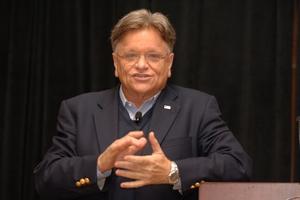Conversation with HSNWRandall Larsen, executive director of the WMD Commission
Critics point out that Project BioShield, created in 2003 to address the lack of medical countermeasures to deal with chemical, biological, radiological, or nuclear terrorism agents, is yet to deliver a single vaccine to any of the known bioterror agent; they also point out to the cancellation of a $877.5 million contract with an inexperienced San Francisco company to develop an anthrax vaccine as emblematic of the program; Randall Larsen, executive director of the WMD Commission, argues that “There are always going to be problems when you’re making a new stealth bomber, nuclear powered submarine, or pharmaceutical for biodefense—- “; he also points out that the EPA R&D budget is about half the budget of the Marine Corp. marching band

Randall Larsen, executive director of the WMD Commission // Source: biodefenseconference.com
In 2003 President George W. Bush proposed Project BioShield to address the lack of medical countermeasures to deal with chemical, biological, radiological, or nuclear (CBRN) terrorism agents. Eight years later, the 112th congress must address the cuts in BioShield funding contained in the DHS Appropriations Act. The act explicitly stated that grants were not to be used for other purposes; whether or not the project fulfilled its objectives by FY 2013. Congress must also decide what to do in the event that the project fails to meet its goals. Before the act became law in July of 2004, a Statement of Administration Policy published in May of that year outlined Project BioShield’s four goals:
- speed the government’s ability to turn promising scientific discoveries into necessary countermeasures
- authorize funding to purchase critical new countermeasures targeted against the most worrisome threats
- allow the FDA to make treatments quickly available to Americans in emergency situations
- transfer funding authority for the Strategic National Stockpile (SNS) from DHS to the Department of Health and Human Services (HHS).
The SNS contains pharmaceuticals, vaccines, medical supplies, and medical equipment to respond to terrorist attacks and other emergencies.
The 109th Congress passed the Pandemic and All-Hazard Preparedness Act which created the Biomedical Advanced Research and Development Authority (BARDA) in HHS. This act also enabled HHS to purchase unapproved and unlicensed countermeasures at a lower cost than approved products since larger pharmaceutical companies would not reap a significant profit investing in the development and manufacturing of vaccines.
Poor government planning, reliability problems, and the rescission of an $877.5 million federal contract from VaxGen, a San Francisco-based pharmaceutical company that focused on the development of an anthrax vaccine, led to the turnover of anthrax vaccine development to Maryland-based Emergent Biosolutions.
Homeland Security NewsWire spoke with Randall Larsen, executive director of the bipartisan WMD Terrorism Research Center, formerly the Commission on the Prevention of Weapons of Mass Destruction Proliferation and Terrorism (WMD commission) about project BioShield and the termination of the VaxGen contract. Larsen commented that after having spoken to top scientists in the field, they thought the VaxGen contract had been stopped prematurely and that the general consensus on the matter was that “they should have been given a little more time to try to deliver their product.”
When asked why the federal government would entrust such a huge sum to a purportedly inexperienced vaccine firm such as VaxGen, Larsen summed
